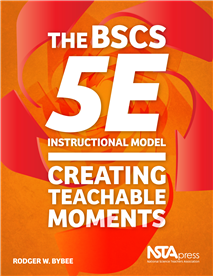Create Teachable Moments for Your Students
By Carole Hayward
Posted on 2015-05-01
 Like classroom teachers at all levels and disciplines, you have probably experienced teachable moments. They are those positive distractions from planned lessons where students are engaged and you have the opportunity to explore ideas and provide an explanation or insight. These are exciting, even magical, moments for teachers.
Like classroom teachers at all levels and disciplines, you have probably experienced teachable moments. They are those positive distractions from planned lessons where students are engaged and you have the opportunity to explore ideas and provide an explanation or insight. These are exciting, even magical, moments for teachers.
In The BSCS 5E Instructional Model: Creating Teachable Moments, author Rodger Bybee explains why a teachable moment occurs:
“Teachable moments occur when individuals experience something they recognize and that has meaning, but they cannot formulate an explanation for the phenomenon or experience. The experience is within their cognitive grasp but beyond their full understanding…. At a slightly deeper level, the student is expressing cognitive disequilibrium with phenomena in the classroom, school, or environment. In short, the student’s current knowledge and understanding do not provide an explanation for something he or she has experienced.”
A former executive director of the Biological Sciences Curriculum Study (BSCS) and an author of this instructional model, Bybee describes the BSCS 5E Instructional Model as an approach to teaching that centers on important content and abilities and that increases the opportunities for teachable moments.
As a classroom teacher, you do not have to wait for something out of the blue; you can create teachable moments by using a sequence of lessons that includes engaging experiences and activities for students, but the experiences should be beyond students’ immediate grasp. Imagine using an instructional sequence that begins with an experience of high interest but is beyond students’ understanding, and then the lessons provide opportunities for students to sort out their ideas and try to explain the initial situation as the sequence continues.
This leads you to the moment where you can help students gain knowledge and understanding of the experience. Then, you provide a situation where students have to apply their new knowledge to another situation. Finally, students and the teacher conclude with an assessment.
What Are the 5Es?
The BSCS instructional model consists of five phases of learning:
- Engage: The goal of this phase is to capture the students’ attention; it need not be a full lesson, but often it is.
- Explore: Students participate in activities that provide the time and opportunities to resolve the mental disequilibrium or dissonance of the engagement experience.
- Explain: Keeping students connected to, and explaining, the teachable moment is the emphasis of this phase.
- Elaborate: Students are involved in learning experiences that expand and enrich the concepts and abilities developed in the prior phases.
- Evaluate: Teachers and students should receive feedback on the adequacy of their explanations and abilities, so students should be involved in activities that are consistent with those of prior phases and designed to assess their explanations.
With this brief introduction, you can see the rich opportunities that the BSCS 5E Instructional Model affords for creating teachable moments for your students. This model will help teachers bridge the gap between research on learning and the realities of classrooms. Once you understand the aims, orientation, and flexibility of the five phases, you can incorporate the unique demands of the Common Core State Standards, NGSS, and other state and local standards.
This book is also available as an e-book.
The mission of NSTA is to promote excellence and innovation in science teaching and learning for all.
Follow NSTA
Disclaimer: The views expressed in this blog post are those of the author(s) and do not necessarily reflect the official position of the National Science Teaching Association (NSTA).


